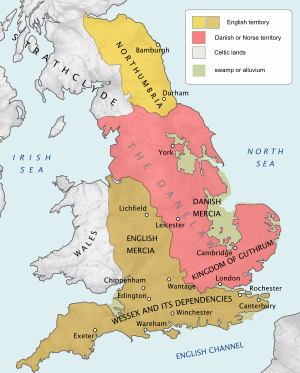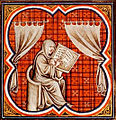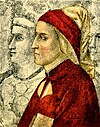Portal:Biography
The Biography Portal
A biography, or simply bio, is a detailed description of a person's life. It involves more than just basic facts like education, work, relationships, and death; it portrays a person's experience of these life events. Unlike a profile or curriculum vitae (résumé), a biography presents a subject's life story, highlighting various aspects of their life, including intimate details of experience, and may include an analysis of the subject's personality.
Biographical works are usually non-fiction, but fiction can also be used to portray a person's life. One in-depth form of biographical coverage is called legacy writing. Works in diverse media, from literature to film, form the genre known as biography.
An authorized biography is written with the permission, cooperation, and at times, participation of a subject or a subject's heirs. An autobiography is written by the person themselves, sometimes with the assistance of a collaborator or ghostwriter. (Full article...)
Featured biographies –

Donald Forrester Brown, VC (23 February 1890 – 1 October 1916) was a New Zealand recipient of the Victoria Cross (VC), the highest award for valour "in the face of the enemy" that can be awarded to British and Commonwealth forces.
Born in Dunedin, Brown was a farmer when the First World War began in 1914. In late 1915, he volunteered for service abroad with the New Zealand Expeditionary Force (NZEF) and was posted to the 2nd Battalion, the Otago Infantry Regiment. He saw action on the Western Front, and was awarded the VC for his actions during the Battle of Flers–Courcelette in September 1916. As he was killed several days later during the Battle of Le Transloy, the award was made posthumously. His VC was the second to be awarded to a soldier serving with the NZEF during the war and was the first earned in an action on the Western Front. (Full article...)
Wulfhere or Wulfar (died 675) was King of Mercia from 658 until 675 AD. He was the first Christian king of all of Mercia, though it is not known when or how he converted from Anglo-Saxon paganism. His accession marked the end of Oswiu of Northumbria's overlordship of southern England, and Wulfhere extended his influence over much of that region. His campaigns against the West Saxons led to Mercian control of much of the Thames valley. He conquered the Isle of Wight and the Meon valley and gave them to King Æthelwealh of the South Saxons. He also had influence in Surrey, Essex, and Kent. He married Eormenhild, the daughter of King Eorcenberht of Kent.
Wulfhere's father, Penda, was killed in 655 at the Battle of Winwaed, fighting against Oswiu of Northumbria. Penda's son Peada became king under Oswiu's overlordship but was murdered six months later. Wulfhere came to the throne when Mercian nobles organized a revolt against Northumbrian rule in 658 and drove out Oswiu's governors. (Full article...)
Air Vice Marshal Ellis Charles Wackett, CB, CBE (13 August 1901 – 3 August 1984) was a senior commander in the Royal Australian Air Force (RAAF). Its chief engineer from 1935 to 1959, he served on the RAAF's controlling body, the Air Board, for a record seventeen years, and has been credited with infusing operations with new standards of airworthiness. Commencing his service career as a Royal Australian Navy cadet during World War I, Wackett transferred to the Air Force in 1923 while on an engineering course in Britain. He qualified as a pilot before completing his studies and returning to Australia, where he inaugurated parachute instruction within the RAAF and made the country's first freefall descent from a military aircraft in 1926. The following year, he led a three-month survey flight to Papua New Guinea.
Wackett became the RAAF's senior engineer with his appointment as Director of Technical Services in 1935. A wing commander at the outbreak of World War II, he rose to air commodore by 1942 and assumed the role of Air Member for Engineering and Maintenance. He established the Technical Branch as a separate department of the RAAF in 1948, and was promoted to air vice marshal the same year. Wackett served as Air Member for Technical Services until leaving the military in 1959, having been appointed Commander of the Order of the British Empire and Companion of the Order of the Bath. From 1960 to 1968, he was a member of the Australian National Airlines Commission, parent of Trans Australia Airlines. Generally known as "Wack", or "EC" (to distinguish him from his elder brother, aircraft designer Lawrence James Wackett or "LJ"), his prominent chin and nose also earned him the nickname "Punch". He died in 1984, aged 83. (Full article...)
Æthelflæd (c. 870 – 12 June 918) ruled as Lady of the Mercians in the English Midlands from 911 until her death in 918. She was the eldest child of Alfred the Great, king of the Anglo-Saxon kingdom of Wessex, and his wife Ealhswith.
Æthelflæd was born around 870 at the height of the Viking invasions of England. By 878, most of England was under Danish Viking rule – East Anglia and Northumbria having been conquered, and Mercia partitioned between the English and the Vikings – but in that year Alfred won a crucial victory at the Battle of Edington. Soon afterwards the English-controlled western half of Mercia came under the rule of Æthelred, Lord of the Mercians, who accepted Alfred's overlordship. Alfred adopted the title King of the Anglo-Saxons (previously he was titled King of the West Saxons like his predecessors) claiming to rule all Anglo-Saxon people not living in areas under Viking control. In the mid-880s, Alfred sealed the strategic alliance between the surviving English kingdoms by marrying Æthelflæd to Æthelred. (Full article...)
Emma Louisa Turner or E L Turner FLS, FZS, HMBOU (9 June 1867 – 13 August 1940) was an English ornithologist and pioneering bird photographer. Turner took up photography at age 34, after meeting the wildlife photographer Richard Kearton. She joined the Royal Photographic Society (RPS) in 1901, and by 1904 she had started to give talks illustrated with her own photographic slides; by 1908, when aged 41, she was established as a professional lecturer.
Turner spent part of each year in Norfolk, and her 1911 image of a nestling bittern in Norfolk was the first evidence of the species' return to the United Kingdom as a breeding bird after its local extinction in the late 19th century. She also travelled widely in the United Kingdom and abroad photographing birds. (Full article...)
John Linton Treloar, OBE (10 December 1894 – 28 January 1952), commonly referred to during his life as J. L. Treloar, was an Australian archivist and the second director of the Australian War Memorial (AWM). During World War I he served in several staff roles and later headed the First Australian Imperial Force's (AIF) record-keeping unit. From 1920 Treloar played an important role in establishing the AWM as its director. He headed an Australian Government department during the first years of World War II, and spent the remainder of the war in charge of the Australian military's history section. Treloar returned to the AWM in 1946, and continued as its director until his death.
Treloar's career was focussed on the Australian military and its history. Prior to World War I he worked as a clerk in the Department of Defence and, after volunteering for the AIF in 1914, formed part of the Australian Army officer Brudenell White's staff for most of the war's first years. He was appointed commander of the Australian War Records Section (AWRS) in 1917. In this position, he improved the AIF's records and collected a large number of artefacts for later display in Australia. Treloar was appointed the director of what eventually became the AWM in 1920, and was a key figure in establishing the Memorial and raising funds for its permanent building in Canberra. He left the AWM at the outbreak of World War II to lead the Australian Government's Department of Information, but was effectively sidelined for much of 1940. In early 1941 he was appointed to command the Australian military's Military History and Information Section with similar responsibilities to those he had held during World War I. He attempted to intervene in the management of the AWM during his absence, however, to the increasing frustration of its acting director. Treloar worked intensely in all his roles and suffered periods of ill-health as a result. Following the war, he returned to the Memorial in 1946 but his performance deteriorated over time, possibly due to exhaustion. He died in January 1952. (Full article...)

Peter Charles van Geersdaele OBE (3 July 1933 – 20 July 2018) was an English conservator best known for his work on the Sutton Hoo ship-burial. Among other work he oversaw the creation of a plaster cast of the ship impression, from which a fibreglass replica of the ship was formed. He later helped mould an impression of the Graveney boat, in addition to other excavation and restoration work.
Van Geersdaele studied at Hammersmith Technical College from 1946 to 1949, after which he engaged in moulding and casting at the Victoria and Albert Museum until 1951. From 1954 to around 1976 he was a conservator at the British Museum, rising to the position of senior conservation officer in the British and Medieval department. Following that he became an assistant chief of archaeology in the conservation division of the National Historic Sites of Canada for Parks Canada, and then the deputy head of the conservation department at the National Maritime Museum in London. He retired in 1993, and during that year's Birthday Honours was appointed an Officer of the Order of the British Empire, in recognition of his services to museums. (Full article...)

Æthelwold (/ˈæθəlwoʊld/) or Æthelwald (died 13 December 902) was the younger of two known sons of Æthelred I, King of Wessex from 865 to 871. Æthelwold and his brother Æthelhelm were still infants when their father the king died while fighting a Danish Viking invasion. The throne passed to the king's younger brother (Æthelwold's uncle) Alfred the Great, who carried on the war against the Vikings and won a crucial victory at the Battle of Edington in 878.
After Alfred's death in 899, Æthelwold disputed the throne with Alfred's son, Edward the Elder. As senior ætheling (prince of the royal dynasty eligible for kingship), Æthelwold had a strong claim to the throne. He attempted to raise an army to support his claim, but was unable to get sufficient support to meet Edward in battle and fled to Viking-controlled Northumbria, where he was accepted as king. In 901 or 902 he sailed with a fleet to Essex, where he was also accepted as king. (Full article...)
Alfred John Shout, VC, MC (8 August 1882 – 11 August 1915) was a New Zealand–born soldier and an Australian recipient of the Victoria Cross (VC), the highest decoration for gallantry "in the face of the enemy" awarded to members of the British and Commonwealth armed forces. Shout was posthumously awarded the VC for his actions at Lone Pine in August 1915, during the Gallipoli campaign of the First World War. After Ottoman forces had counterattacked and seized a large stretch of the Australians' front line, Shout gathered a small party of men and charged down one trench throwing bombs. He killed eight Turkish soldiers, and managed to clear others to retake the trench. In a similar action later that day, and supported by another officer, he recaptured further ground amid hard fighting. In the final push forward, Shout simultaneously lit three bombs to lob at the enemy. He successfully threw two, but just as the third left his hand it detonated. Shout was grievously wounded; he died two days later.
Born in Wellington, Shout had served in the Second Boer War as a teenager. He rose to sergeant and was mentioned in despatches for saving a wounded man before being discharged in 1902. He remained in South Africa for the next five years, serving as an artilleryman in the Cape Colonial Forces from 1903. With his Australian-born wife and their daughter, Shout immigrated to Sydney in 1907. The family settled in Darlington, where Shout worked for Resch's Brewery as a carpenter and joiner. He was also active in the part-time Citizens' Forces, being commissioned just prior to the outbreak of the First World War. In August 1914, he joined in the Australian Imperial Force (AIF) for active service overseas and was appointed a lieutenant in the 1st Battalion. After training in Egypt, he took part in the Anzac landings at Gallipoli on 25 April 1915. For his leadership during the invasion and its immediate aftermath, Shout was awarded the Military Cross and later mentioned in despatches. Shout's three gallantry awards at Gallipoli made him the most highly decorated member of the AIF for the campaign. (Full article...)














































